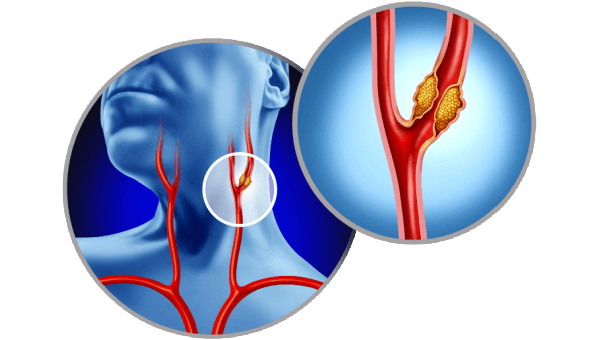About Carotid Artery Stenosis
Carotid artery stenosis, or carotid artery disease, occurs when atherosclerosis (plaque buildup) develops in one or both carotid arteries. The carotid arteries are the two major arteries that carry blood to the head, face and brain. They are located on each side of the neck.
When the carotid arteries narrow and build up plaque, it is called “stenosis”. This stenosis restricts blood flow that gets to the brain. If the brain does not get enough blood, it cannot get the oxygen and nutrients it needs to work properly and can lead to an ischemic stroke. Carotid artery stenosis causes roughly 8% of ischemic strokes and transient ischemic attacks (TIAs).
Symptoms of Carotid Artery Stenosis
Carotid artery stenosis often has no symptoms, especially in early stages. A faint whistling sound, called a "bruit," may be heard with a stethoscope, but it’s not always present. If stenosis causes an ischemic stroke or TIA, sudden stroke-like symptoms may occur:
- Numbness or weakness on one side of the body (face, arms or legs)
- Slurred speech and trouble understanding speech
- Blurred vision
- Dizziness
- Loss of coordination or balance
- Severe headache
Causes and Risk Factors
Many patients have no symptoms until a stroke, so it's important to be aware of your risk factors, including:
- High blood pressure can cause pressure in the carotid arteries, which can weaken them and accelerate plaque buildup over time.
- Tobacco use and smoking can irritate the inner lining of the carotid arteries.
- Diabetes affects the ability to process fats causing risks for high blood pressure and atherosclerosis.
- High blood-fat levels can cause the buildup of plaque.
- High blood sugar is linked to strokes and often an early indicator of carotid stenosis.
- Family history increases the risk for carotid stenosis if you have blood relatives with it or CAD.
- Age
- Obesity increases the chances of high blood pressure, atherosclerosis and diabetes.
- Sleep apnea
- Lack of exercise
Diagnosing Carotid Artery Stenosis
If your risk factors are high, your physician may perform further tests to check for carotid artery stenosis. One test involves listening for an abnormal rushing sound, or bruit, with a stethoscope, which may indicate carotid artery disease. However, bruits aren’t always present. If necessary, your physician may recommend additional diagnostic tests, such as:
-
Carotid Ultrasound
-
Magnetic Resonance Angiography (MRA)
-
Computerized Tomography Angiography (CTA)
-
Carotid Angiography
This noninvasive and painless screening test uses high-frequency sound waves to generate an image of the carotid arteries and can be helpful in identifying narrowing in the carotid arteries. Carotid ultrasounds are performed in a variety of locations including vascular surgery offices, BayCare Outpatient Imaging and diagnostic cardiology departments at these BayCare facilities:
MRA is a type of magnetic resonance image (MRI) scan and is used to examine blood vessels throughout the body. It does this by using a magnetic field and radio waves to provide an image of the carotid arteries. This test can provide a physician with important information about carotid and vertebral arteries and the degree of stenosis. MRAs are performed at BayCare Imaging Centers.
During this CT scan, a dye is injected into the patient’s arm to highlight the blood vessels and obtain a high-resolution, 3D image of the carotid artery. These CTA images help physicians determine the degree of stenosis in the carotid and vertebral arteries. CTA imaging can be scheduled through a BayCare Imaging Center.
This imaging procedure, sometimes referred to as a cerebral angiography, is a blood flow test using a catheter placed in the groin or arm. Dyes are injected into the patient’s blood vessels, while an X-ray is being taken to produce a picture of the patient’s blood flow. This procedure assists the physician in determining exactly where the narrowing is located and will help to guide further treatments. Carotid angiography is performed inside the catheterization labs at these BayCare hospitals:
-
Lifestyle Changes
-
Medications
-
Carotid Angioplasty and Stenting
-
Carotid Endarterectomy (CEA)
-
Transcarotid Artery Revascularization (TCAR)
Lifestyle changes such as a healthy diet and daily movement or exercise can reduce the progression of carotid artery stenosis. Some other lifestyle tips or prevention include:
- No smoking or tobacco use
- Maintain a healthy weight
- Limit cholesterol, fats, and salt intake
- Minimize alcohol consumption
- Manage conditions like diabetes and high blood pressure
Medications are prescribed to improve blood flow and reduce stroke risk in those with carotid stenosis, typically by your primary care doctor, cardiologist, or vascular surgeon:
- Anti-platelet medications (e.g., Aspirin) prevent blood cells from forming clots.
- Anticoagulants (e.g., Warfarin) decrease the blood’s ability to produce clots.
- Blood pressure medications relax and widen blood vessels for better blood flow.
- Cholesterol medications help prevent further cholesterol buildup in arteries.
During a carotid angioplasty, a vascular surgeon will use a catheter to insert a small balloon to open the artery. A small incision is placed in the neck just above the collarbone (transcarotid approach) or in the groin (transfemoral approach). Once the ballon is expanded, the surgeon may place a stent, made of metal-mesh material to open the carotid artery. During the balloon and stenting process, an embolic protection device (a small filter) may be used to catch any debris. Carotid angioplasty and/or stenting are performed at the following BayCare hospitals:
During this surgical procedure, a vascular surgeon makes a small incision in the neck and surgically removes the plaque from the artery by delicately opening the carotid artery and repairing the diseased portion of that artery. This repair may involve stitches or patch graft (made with a vein or other material) on the artery. Eversion carotid endarterectomy can also be used where the vascular surgeon will turn the artery inside out to remove the plaque and return or reattach the artery into place. Once carotid artery is repaired, blood flow is restored. CEA is performed at these BayCare hospitals:
TCAR is a less-invasive treatment alternative to carotid endarterectomy that’s recommended for patients who are considered too high risk for surgery. Through a small incision in the neck, a vascular surgeon places a device that temporarily reverses the blood flow in the carotid artery to protect the brain from any plaque. While the blood flow is reversed, the vascular surgeon places a stent directly into the carotid artery through a catheter. Once the stent is in place, the blood flow device is removed and blood flows normally. TCAR is performed at these BayCare hospitals:

What You Need To Know About Carotid Artery Stenosis
Dr. Yves A. Gabriel leads an informative discussion about Carotid Stenosis, including how it is diagnosed, and treatment/management options.
Frequently Asked Questions
-
Can I be screened for carotid artery stenosis?
Talk with your primary care physician about your risk factors for various conditions including heart and stroke risks. According to American Heart Association, those with high blood pressure, elevated cholesterol, high blood sugar, diabetes and obesity are at higher risk and benefit from screening and healthy lifestyle changes.
-
What types of screening options exist for carotid artery stenosis?
Though routine or yearly screening for carotid stenosis isn’t currently recommended for the general population, you may quality for screening using carotid ultrasound. To see if screening with carotid ultrasound is right for you, talk with your primary care doctor, cardiologist, or vascular specialist about your medical history and current conditions.
Request a Cardiovascular Specialist Referral
Diagnosed with carotid stenosis and looking treatment options? Let us help you find a vascular surgeon. Fill out the form and select vascular surgeon.
Not sure if you have carotid stenosis? Talk with your primary care doctor. If you need a primary care doctor, fill out the form and select "Family Medicine" or "Internal Medicine."


